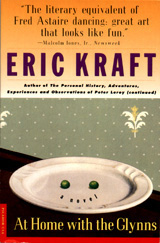
YOU CAN READ
THE FIRST HALF OF
THE BOOK
(21 CHAPTERS)
HERE,
ONLINE,
OR,
FOR MAXIMUM PORTABILITY
AND CONVENIENCE
WHEN READING
ON THE BEACH
OR
IN THE TUB,
YOU CAN BUY THE
PICADOR USA
PAPERBACK EDITION AT
AMAZON.COM
OR
YOU CAN DOWNLOAD
THE COMPLETE TEXT
AS AN
eBOOK
AND

For Mad
Show me an epigraph and I’ll show you a novel which has too good an
idea of what it’s about.
![]() Stanley
Elkin, “The Graduate Seminar”
Stanley
Elkin, “The Graduate Seminar”
![]()
The artist cannot dignify officialdom by opposing it in a solemn fashion,
because that would mean taking it too seriously and inadvertently reinforcing
its authority, thus acknowledging that authority. . . . In today’s rushed,
confusing society in which everything mixes and is mixed up and destroyed,
the ridiculous does run the risk of “swallowing up” art too. But the artist,
even if he has been relegated to the position of a buffoon, tries to assume
. . . an ambiguous stance, to place himself on a shaky seesaw, to transform
the loss into a later gain.
![]() Norman
Manea, On Clowns: The Dictator and the Artist
Norman
Manea, On Clowns: The Dictator and the Artist
![]()
It is very good to copy what one sees; it is much better to draw what
you can't see any more but in your memory. . . . That way, your memories
and your fantasy are freed from the tyranny of nature.
![]() Edgar
Degas to Georges Jeanniot
Edgar
Degas to Georges Jeanniot
![]() (quoted
by Otto Friedrich in Olympia: Paris in the Age of Manet)
(quoted
by Otto Friedrich in Olympia: Paris in the Age of Manet)
![]()
All good and true draughtsmen draw from the image imprinted on their
brains, and not from nature. . . . When a true artist has come to the point
of the final execution of his work, the model would be more of an embarrassment
than a help to him.
![]() Charles
Baudelaire, “The Painter of Modern Life”
Charles
Baudelaire, “The Painter of Modern Life”
![]() (translated
by Jonathan Mayne)
(translated
by Jonathan Mayne)
![]()
The certainty that life cannot be long, and the probability that it
will be much shorter than nature allows, ought to awaken every man to the
active prosecution of whatever he is desirous to perform.
![]() Samuel
Johnson, Rambler 134
Samuel
Johnson, Rambler 134
![]()
Suppose Sonia tries her best to enact a paradox. She resolves that tomorrow
she will enter the time machine and emerge today, unless a version of her
first emerges today, having set out from tomorrow; and that if a version
of her does emerge today, she will not enter the time machine tomorrow.
Within classical physics, that resolution is self-contradictory. But not
under quantum physics. In half the universes—call them A—an older Sonia
steps out of the time machine. Consequently, just as she resolved, Sonia
does not enter the time machine tomorrow, and each A-universe thereafter
contains two Sonias of slightly different ages. In the other (B) universes,
no one emerges from the time machine. . . .
![]() So
in half the universes there is a meeting between two Sonias, and in half
there is not. In the A-universes an older Sonia appears “from nowhere,”
and in the B-universes she disappears “into nowhere.” Each A-universe then
contains two Sonias, the older one having started life in a B-universe.
Sonia has gone missing from each B-universe, having emigrated to an A-universe.
. . .
So
in half the universes there is a meeting between two Sonias, and in half
there is not. In the A-universes an older Sonia appears “from nowhere,”
and in the B-universes she disappears “into nowhere.” Each A-universe then
contains two Sonias, the older one having started life in a B-universe.
Sonia has gone missing from each B-universe, having emigrated to an A-universe.
. . .
![]() Suppose
that Sonia’s boyfriend, Stephen, stays behind while she uses her time machine
in one of the ways we have described. In half the universes, she enters
it and never returns. Thus, from Stephen’s point of view, there is a possibility
that he will be separated from her. Half the versions of him will see Sonia
departing, never to return. (The other half will be joined by a second
Sonia.) But from Sonia’s point of view, there is no possibility of her
being separated from Stephen, because every version of her will end up
in a universe containing a version of him—whom she will have to share with
another version of herself.
Suppose
that Sonia’s boyfriend, Stephen, stays behind while she uses her time machine
in one of the ways we have described. In half the universes, she enters
it and never returns. Thus, from Stephen’s point of view, there is a possibility
that he will be separated from her. Half the versions of him will see Sonia
departing, never to return. (The other half will be joined by a second
Sonia.) But from Sonia’s point of view, there is no possibility of her
being separated from Stephen, because every version of her will end up
in a universe containing a version of him—whom she will have to share with
another version of herself.
![]() from
“The
Quantum Physics of Time Travel”
from
“The
Quantum Physics of Time Travel”
![]() David
Deutsch and Michael Lockwood
David
Deutsch and Michael Lockwood
![]() Scientific
American, March 1994
Scientific
American, March 1994
![]() Copyright
© 1994 by Scientific American, Inc. All rights reserved.
Copyright
© 1994 by Scientific American, Inc. All rights reserved.

CLICK TO ENLARGE
Composed by Zenta Sato
“The aging Peter, in his room in Small’s Hotel, brings to mind this
scene from his past: On Main Street at night, a gentle breeze is blowing,
as in chapters 25, 26, and 27. There he sees the Glynn twins and . . .
himself, young Peter! The three of them are walking . . . no, no,
they are waltzing, three pure souls dancing in the night air. He
watches the three of them walking, and waltzing, and feels the bittersweet
pain of nostalgia, and hears, in the distance, ringing bells: a new day
has begun for him.”

Support the Work
Tip the Author
I should like to see the custom introduced of readers who are pleased with a book sending the author some small cash token: anything between half-a-crown and a hundred pounds. Authors would then receive what their publishers give them as a flat rate and their “tips” from grateful readers in addition, in the same way that waiters receive a wage from their employers and also get what the customer leaves on the plate. Not more than a few hundred pounds—that would be bad for my character—not less than half-a-crown—that would do no good to yours.
![]() Hilariously
Erotic
Hilariously
Erotic![]()
—Edward Hannibal, The East Hampton Star

DO YOU HAVE YOUR COPY?
You should be able to find At Home with the Glynns at your local bookstore, but you can also order it by phone from:
- Bookbound at 1-800-959-7323
Book Call at 1-800-255-2665 (worldwide 1-203-966-5470)
LITTLE
FOLLIES
HERB
’N’ LORNA
RESERVATIONS
RECOMMENDED
WHERE
DO YOU STOP?
WHAT
A PIECE OF WORK I AM
AT
HOME WITH THE GLYNNS
LEAVING
SMALL’S HOTEL
PASSIONATE
SPECTATOR
MAKING
MY SELF
A
TOPICAL GUIDE
At Home with the Glynns Copyright © 1995 by Eric Kraft
At Home with the Glynns is a work of fiction. The characters, incidents, dialogues, settings, and businesses portrayed in it are products of the author's imagination and are not to be construed as real. Any resemblance to actual events or persons, living or dead, is entirely coincidental.
All rights reserved. No part of this book may be reproduced or transmitted in any form or by any means, electronic or mechanical, including photocopying, recording, or by any information storage and retrieval system, without permission in writing from the publisher.
First published by Crown Publishers, Inc., 201 East 50th Street, New York, New York 10022. Member of the Crown Publishing Group.
The illustration at the top of the page is an adaptation of an illustration
by Stewart Rouse that first appeared on the cover of the August 1931 issue
of Modern Mechanics and Inventions. The boy at the controls of the
aerocycle doesn’t particularly resemble Peter Leroy—except, perhaps, for
the smile.
![]()

